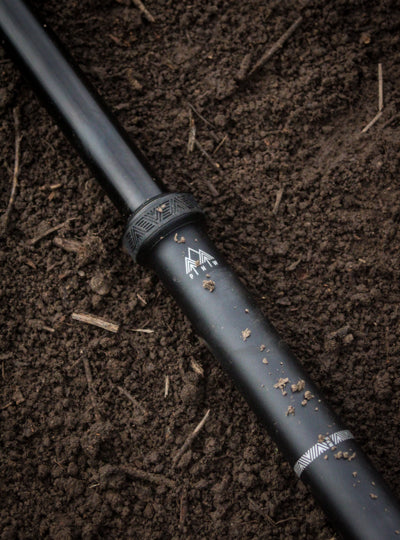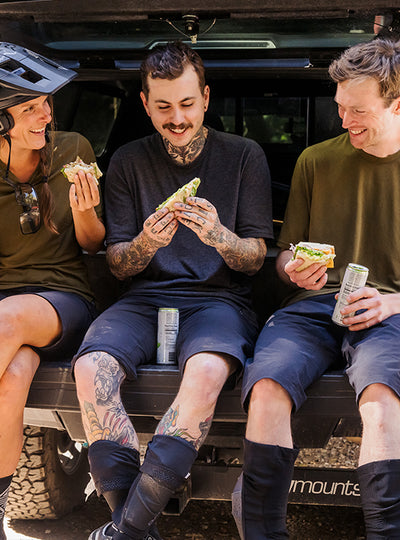Cornu Copiae, ah, the horn of abundance. A 3,000-year-old symbol dating back to when baby Zeus, the Greek king of all gods, was at risk of being eaten by his father Kronos. To protect baby Zeus from being eaten, he was hidden in a cave where the goat Amalthea cared for him and provided his nourishment. Zeus, being a mighty god, was a bit heavy-handed and he accidentally broke off one of her horns, that horn then had the power to provide an endless supply of food.
We’d love to break off a horn and provide our riders with an endless supply of food, but we’re not magical goat goddesses. So instead we’ll be sharing some free recipes all week long. These recipes are tried and tested and we’re stoked to share the abundance with you. Thanks for coming to our table, you’re always welcome here, even if you drink all the wine again.
ALL-BUTTER CRUST
You can’t have pie without crust, and if someone tells you that you can, they’re wrong. The best kind of crust is arguably an all-butter crust, extra flaky, just a little bit salty, and obviously extremely buttery. The smell of a pie baking in an all-butter crust is possibly one of the best smells on earth.
Yield: (2) 9” Pie Crusts (top & bottom for a double crust pie, or 2 bottom crusts)
INGREDIENTS
- 2 ½ cups all-purpose flour (300g)
- ½ teaspoon fine sea salt (2g)
- 1cup cold unsalted butter, cut into ½ inch cubes (226g) (2 sticks)
INSTRUCTIONS
-
In a large bowl, whisk together the flour and salt. Add the cubed butter, using your fingers toss the cubes through the flour until each piece is well coated. ‘Cut’ the butter into the flour by pressing the pieces between your fingers, flattening the cubes into big shards. Toss the butter through the flour coating each piece well.
-
For a flaky crust, continue cutting the butter into the flour just until the largest pieces of butter are about the size of quarters some pieces will be smaller like peas. If you continue to mix in the butter to smaller pieces the crust will be less flaky, do as you prefer.
-
Make a well in the center of the flour/butter mixture. Add ½ cup ice water to the well, but be sure to have more on hand. Use a tossing motion with your hands to begin mixing. As it begins to become hydrated, you can start to use more of a kneading motion to bring the mixture together, be gentle to avoid over-activating the gluten.
-
Add more water about 2 tablespoons at a time until the dough is properly hydrated: it should be uniformly combined and hold together easily, but it won’t look perfectly smooth. Go slow and do not over-hydrate the dough. Dough that is too dry may have sort of a “dusty” appearance or pockets of un-hydrated flour. It will not hold together and will appear crumbly. Dough that is too wet will feel sticky or tacky to the touch.
-
Form the dough into 2 even disks. Wrap tightly in plastic wrap and refrigerate for at least 30 minutes-1 hour.
-
After the dough has rested in the fridge for at least 30 minutes. On a lightly floured surface, roll out the dough to about ½ inch don’t worry about the shape at this stage. (If the dough feels sticky to the touch, re-wrap it in plastic wrap, and refrigerate it for another 30 minutes before proceeding.) Brush away any excess flour from the surface of the dough, and fold it in half horizontally. Then, fold the dough in half again (you’ve now folded it into quarters).
-
Tuck the end of your folded dough under itself to create a round disk of dough. Wrap it tightly in plastic wrap, and refrigerate for at least 1 hour, and up to 2 days before using. Or, freeze for up to 3 months (thaw overnight in the refrigerator before using).
NOTES
-
If you’re not a stickler for super flaky crust, or you’re short on time, you can skip steps 6 &7 and roll out the dough to bake after it’s rested for at least 30 minutes.
-
To Roll Out the Dough: Lightly dust a work surface with flour, and lightly dust a rolling pin. Roll out the dough to about ¼ inch, rotating it as you work to help prevent it from sticking. To transfer the dough to the pan, gently roll it up, wrapping it around the pin, then unfurl it into the pie plate.
-
NO SOGGY BOTTOMS: Par-Baking is partially baking the crust, before filling and then baking again once filled. This works best for single-crust pies like pumpkin or pecan. Roll-out your dough and crimp it into the pie pan. Poke the crimped across the bottom with a fork and chill well (at least 30 minutes). Cut a square of parchment paper slightly larger than the diameter of a pie plate, and press it into the base of the pie plate. Fill with pie weights (dried beans will work in a pinch) to the top inner rim of the pie plate. Bake in a 425°F / 220°C oven until the edges begin to lightly brown, 15-17 minutes. Remove the parchment paper and pie weights, and return to the oven until the lower portion of the crust appears dry and set, 2-3 minutes more. Cool completely before filling and finish your bake according to the recipe for the pie you’re making.
CREDIT WHERE CREDIT IS DUE
This recipe was adapted from Erin Jean McDowell.
PUMPKIN BARS
Pumpkin pie is delicious, it’s decadent, and you typically only eat it once a year, but sadly, not everyone loves it the way we do. Our solution to please the masses? Pumpkin Bars. Any church lady will tell ya, if you make it into a bar and put cream cheese frosting on it, it will disappear quickly. You can eat these for breakfast, dessert, with an afternoon coffee after your ride, you can make them any time of the year without feeling too weird. Sometimes it’s good to be a people pleaser.
Yield: ~24 Bars
INGREDIENTS
Pumpkin Bars
-
2 cups all-purpose flour (284g)
-
2 teaspoons baking powder
-
2 teaspoons ground cinnamon
-
1 teaspoon baking soda
-
1 teaspoon fine salt
-
3/4 teaspoon ground ginger
-
1/2 teaspoon ground nutmeg
-
Pinch of cloves
-
15ozs unsweetened pumpkin puree (425g)
-
4 large eggs at room temperature
-
1 cup neutral oil, such as canola or grapeseed (240g)
-
3/4 cup granulated sugar (150g)
-
3/4 cup brown sugar (150g)
-
3 tablespoons maple syrup
-
1 teaspoon pure vanilla extract
Cream Cheese Frosting
-
8 ozs cream cheese at room temperature (226g)
-
8 tablespoons (1 stick | 113g) unsalted butter at room temperature
-
Pinch salt
-
2 teaspoons pure vanilla extract
-
4 cups confectioners’ sugar (480 g)
INSTRUCTIONS
The Bars:
-
Adjust an oven rack to the middle position and preheat the oven to 350F [180C]. Grease a half-sheet pan.
-
In a medium bowl, whisk together the flour, baking powder, cinnamon, baking soda, salt, ginger, nutmeg, and cloves.
-
In a large bowl whisk together the pumpkin, eggs, canola oil, sugars, maple syrup, and vanilla until combined.
-
Add the dry ingredients to the large bowl and stir until completely combined. Whisk the batter to get rid of any lumps; about 30 seconds.
-
Spread the batter evenly in the prepared pan, using an offset spatula to smooth the top. Bake the bars until they are set and a toothpick comes out clean, 15 to 20 minutes.
The Frosting:
-
In the bowl of a stand mixer fitted with a paddle, beat the cream cheese, butter, and salt together on low speed until smooth, creamy, and combined, 2 to 3 minutes.
-
With mixer on low, add vanilla, and mix until combined. Gradually add the confectioners’ sugar and mix on low until combined, scraping down the sides as necessary.
Assembly:
-
Completely cool the bars before frosting. Dollop the frosting over the bars and use an offset spatula to spread it evenly. Bars will slice best if chilled; place the pan in the refrigerator for 1 hour before slicing. Slice the bars and serve. Bars will keep for several days in the refrigerator in an airtight container.
CREDIT WHERE CREDIT IS DUE
This recipe was adapted from Sarah Kieffer.
FALL SALAD
This week can get a little wild, it feels like a good day for a salad. This recipe is a classic, you can easily change it up to follow your gut, and your fridge contents. You can switch out the squash and fruits, make it with whatever greens you have on hand, skip the goat cheese, or replace it with feta, whatever feels right.
Yield:Serves 2 as a Main, 6 as a Side
INGREDIENTS
-
Olive oil
-
Kosher salt
-
Freshly ground black pepper
-
1lb (455 grams) honeynut squash or garnet yams, peeled, seeded, and sliced thin (¼-inch)
-
2 medium shallots, halved lengthwise and peeled
-
8 ozs greens of choice, spinach, chopped kale, arugula, or a mix are all great
-
3 tablespoons sherry vinegar or balsamic vinegar, plus more to taste
-
¾ teaspoon smooth Dijon mustard
-
1 to 2 tablespoons water, as needed
-
¼ cup fresh pomegranate seeds, dried cranberries, or dried sour cherries
-
¼ cup thinly sliced apples
-
2 ozs soft goat cheese crumbled, honey flavored is a nice touch
-
½ cup toasted, salted pepitas
INSTRUCTIONS
-
Prepare the squash, shallots, and apples.
-
Heat oven to 400°F and line a large baking sheet with parchment paper. Drizzle or brush parchment lightly with olive oil and sprinkle the oil with salt and pepper. Arrange winter squash slices in one layer on parchment. Coat lightly with more oil, salt, and pepper.
-
Place shallot halves on a square of foil and drizzle lightly with olive oil and kosher salt. Tightly seal them into a little packet and place on the baking sheet with the squash.
-
Roast squash and shallots for 15 minutes, until the squash is lightly brown underneath. Flip the squash pieces and carefully open the foil packet with the shallots. Return the tray to the oven for another 5 to 10 minutes, until the squash is evenly brown. The shallot will not be brown or look caramelized but will be tender, which is all we need..
-
Make the dressing: In a blender or food processor, whiz warm shallots with 4 tablespoons olive oil until smooth, scraping down the bowl as needed. With the machine running, add Dijon mustard and 3 tablespoons vinegar, blend until smooth. Season with salt and pepper, blending again. Taste and adjust with more vinegar, salt, and pepper as needed. If the dressing is very thick, thin it with 1 to 2 tablespoons of water.
-
To serve: In a large wide bowl or salad plate, toss greens with half the dressing and season with additional salt and pepper. Arrange roasted squash over the greens, fanning out slices if you wish. Sprinkle salad with pomegranate (or dried fruit), apples, goat cheese, and pepitas, and drizzle some of the remaining dressing over, to taste. Serve right away, with extra dressing on the side.
CREDIT WHERE CREDIT IS DUE
This recipe was adapted from Deb Perelman
THE CRANNY-B SAUCE
If you do not have any leftover cranberry sauce from your Turkey Day feast, you best make some. It’s the ONLY way to have the SUPERIOR leftover sando. We say this sando is superior because it uses up some of that delicious turkey, but it gives the taste buds a gentle break from the Americana. Make it to-go and eat it with a crispy boy while sitting on your tailgate after a ruckus ride through the forest, your life will be forever changed.
Yield: 2 ½ cups
SAUCE INGREDIENTS
- 1 pound cranberries (fresh or frozen)
- 1 tablespoon finely grated orange zest (from about 1 orange)
- 1 cup fresh orange juice (from about 2 oranges)
- 1/2 cup granulated sugar
- 1 (3-inch) cinnamon stick
- 1 teaspoon kosher salt
- 1/4 teaspoon ground cloves
- 1/8 teaspoon ground nutmeg
INSTRUCTIONS
-
Rinse cranberries and remove any stems
-
Zest your orange, then juice it and another orange
-
In a medium saucepan over medium-high heat, combine the cranberries, orange zest, orange juice, sugar, cinnamon, salt, cloves, and nutmeg. Bring to a boil. Reduce the heat to medium-low, cover, and simmer, mashing the cranberries with the back of a fork occasionally, for about 20 minutes, until the cranberries are translucent, soft, and broken into half. The texture should resemble a loose jam. If you want a chunkier sauce, continue to cook for about 5 minutes to keep reducing the liquid until the desired consistency is achieved. Let cool for about 15 minutes, then remove the cinnamon stick before serving.
-
Do Ahead: The cranberry sauce can be made 5 days ahead. Transfer to an airtight container or jar and store in the refrigerator.
CREDIT WHERE CREDIT IS DUE
This recipe was adapted from Rachel Gurjar.
THE SUPERIOR LEFTOVER SANDO
INGREDIENTS
-
French Baguette
-
Leftover Turkey
-
Cranberry Sauce
-
Thinly sliced apple
-
Brie Cheese (or just butter)
-
Arugula lightly drizzled with olive oil and a sprinkle of salt & pepper
ASSEMBLY
It’s just a sando, make it with these ingredients the way you like it.
Or simply use the Cranny-B Sauce on a Classic Leftover Sando
BLUE MONDAY SMOOTHIE
That Monday back at work after a long weekend can be rough. You might have spent the weekend riding, or maybe you spent it surrounded by loved ones eating yourself into a snooze hole. No matter what, this time of year our immune systems and our moods could use a little boost. Enter: the Blue Monday Smoothie. High in antioxidants and just enough protein, it’s a refreshing little treat to make your week a little bit brighter, and a whole lot bluer (in a good way).
Yield: ~2 Servings
INGREDIENTS
-
2 ripe frozen bananas in chunks
-
½ cup frozen blueberries
-
1 scoop of blue spirulina powder
-
1 large handful of spinach
-
½ cup of plain, vanilla, or honey Greek yogurt (skip if vegan, or replace with plant-based)
-
½ cup - 1 cup of dairy-free milk of choice + more as needed
-
¼ cup oats (skip if you don’t like the texture)
-
Honey or maple syrup if you like it extra sweet
INSTRUCTIONS
-
Place all ingredients into a blender and blend until the texture of your liking
-
Add more liquid as needed
-
Add sweetener as needed
-
Go to work and have a great day honey
WHAT THE HECK IS BLUE SPIRULINA?
Well, it’s some really healthy algae. It’s not for everyone, and we’re not doctors so please head here for more details and find out if it’s a good supplement for you.
















